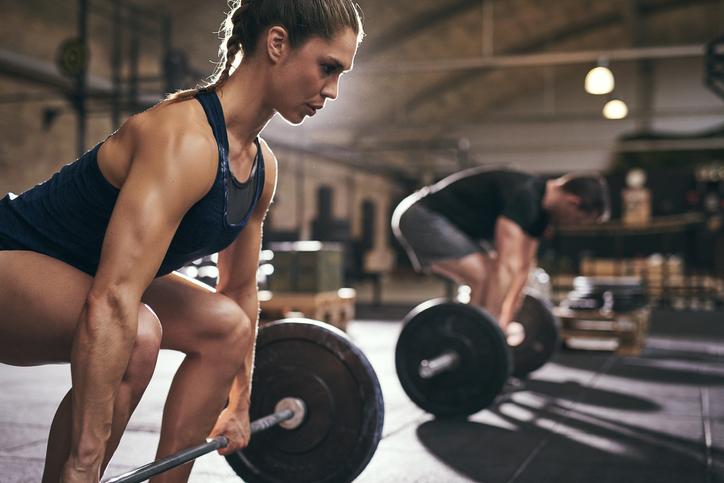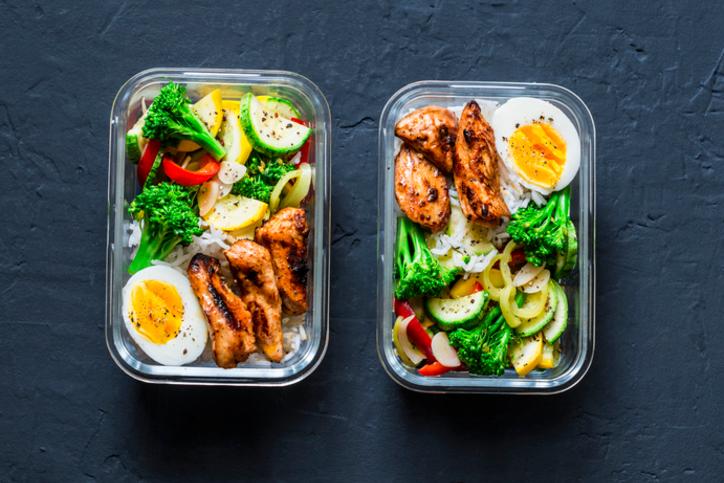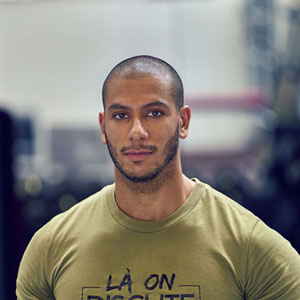8 astuces pour débuter en musculation à la rentrée
La rentrée de septembre est la période parfaite pour se lancer dans de nouvelles activités et se fixer de nouveaux objectifs. Pour certains d’entre vous, ce mois de septembre va peut-être s’accompagner d’une première inscription à la salle de musculation. Quelle bonne nouvelle ! Bon, il est clair que de s’inscrire dans une salle que l’on ne connaît pas, pour se mettre à un sport que l’on ne maîtrise pas, peut effrayer un peu. Mais je vous rassure, il n’y a aucune raison de stresser car avec les bons conseils que je vais vous partager, cette rentrée 2019 sera pour vous la meilleure ! Donc voici votre check list spéciale rentrée ;)
1/ Il n’est pas obligatoire de s’inscrire seul !
Ok, la musculation est un sport qui peut sembler individuel (voire même égoïste selon certains). Mais en réalité, c’est une activité qui peut être basée sur le partage ! Aller à la salle de sport avec un ou une ami(e) peut vous aider à tenir le cap dans les premières semaines de pratique, qui sont parfois les plus difficiles. Qui plus est, s’entourer des bonnes personnes ne peut qu’avoir une incidence positive sur la qualité de vos séances et la vitesse de votre progression. Donc choisissez le bon partenaire d'entraînement et essayez de synchroniser quelques séances en duo chaque semaine.
2/ Aller à la salle avec un plan d’attaque
Et oui ! On ne va pas s’entraîner juste pour s’entraîner. On y va pour atteindre des objectifs. Alors certes, il n'est pas question de se mettre trop de pression au point de ne plus prendre plaisir à faire du sport. Ceci dit, sur le long terme, il est toujours plus judicieux d’avoir une vision claire de l’objectif que vous aimeriez réaliser. Une perte de gras, une prise de muscle, une amélioration du cardio ou de la force…Tout est envisageable. Commencez par vous fixer un objectif atteignable pour vos trois premiers mois de pratique.
Par exemple : “ Mi-décembre, je veux maîtriser la technique du squat et réaliser 10 répétitions à 50 kg. ”
Ou encore: “ Les 10 prochaines semaines, je dois faire deux séances de 40 minutes de cardio en plus de mes deux séances de musculation. ”
Notez ces objectifs et conservez les quelque part où ils seront visibles. En notant ces objectifs, vous vous faites une promesse que vous devez impérativement honorer !

3/ Ne pas négliger l'apprentissage de la technique
La musculation, c’est comme n’importe quel autre sport. On ne peut pas se lancer tête baissée sans avoir un minimum de technique. Plus votre technique sera mauvaise, moins vous aurez de chances de progresser. Malheureusement, le manque de technique augmente aussi les risques de blessures et ça, c’est une très mauvaise nouvelle… Je le sais, pour y être passé, on a tous envie de se mettre sous une barre de développé couché ou de squat dès les premières séances, mais sans une maîtrise correcte de ces mouvements, vous avez plus à y perdre qu’à y gagner. Lorsque j’ai commencé ce sport en 2006, j’ai eu la chance d’être bien entouré. D’abord par mon grand frère qui était vraiment soucieux du respect de la technique, mais aussi de coachs qui m’ont aidé à apprendre certains mouvement de base. J’ai pu apprendre à faire du squat et du soulevé de terre quelques jours après m’être inscrit dans une salle et avec une technique assez bonne pour ne pas risquer la blessure. Alors faites de même et demander de l’assistance à un coach ou un pratiquant plus expérimenté.
4/ Ne copier pas le voisin
C’est tentant de vouloir copier le programme que certains pratiquants suivent avec succès. Que ce soit les programmes vus sur Instagram, YouTube ou sur certains forums ou magazines, on a tous eu envie de reproduire des programmes qui ont, à première vue, fonctionné sur d’autres personnes. Le problème, c’est que c’est souvent une mauvaise idée. Le voisin n’a pas la même expérience, pas les mêmes objectifs, pas la même morphologie et toutes ces variables doivent être prises en compte lorsque vous choisissez de suivre un programme de musculation. Le meilleur conseil est de ne pas brûler les étapes en cherchant à tester des séances qui ne seraient pas adaptées à votre niveau. Je sais, c’est parfois frustrant de se considérer comme “débutant”. Mais c’est dans ces cas là qu’il faut laisser son égo de côté et penser à votre pratique sur le moyen et le long terme.

5/ Allier nutrition et musculation
C’est évident, l’un ne va pas sans l’autre. Vos résultats seront littéralement décuplés si vous faites l’effort de structurer un tant soit peu votre programme diététique. Pas la peine de se restreindre à outrance, il suffit dans un premier temps d’observer quelques règles simples afin de ne pas compromettre votre progression.
Par exemple :
- Consommer assez de protéines. Une activité physique comme la musculation doit forcément s’accompagner d’une consommation suffisante de protéines. Visez pour commencer 1,5 gr de protéines par kilos de poids de corps, tous les jours de la semaine.
- Privilégier les aliments “bruts”. Moins il y a d’ingrédients, mieux c’est !
- Intégrer un maximum de légumes verts. Les brocolis sont à volonté !
- Faire preuve de régularité. Essayer de faire le même nombre de repas tous les jours, que ce soit deux, trois ou quatre.
6/ Être régulier
C’est peut être le PREMIER facteur de progression en musculation. Rome ne s’est pas faite en un jour, votre physique non plus. Il faut un minimum de patience mais surtout un maximum de régularité. S’imposer six entraînements par semaine mais tout arrêter au bout d’un mois ne vous mènera pas bien loin. Pas la peine de vous imposer un rythme infernal si c’est pour abandonner après quelques semaines d’efforts. On commence léger et on augmente la fréquence petit à petit en fonction de ses disponibilités et de ses résultats. Donc il ne faut pas avoir peur de commencer avec deux séances de musculation et d’ajouter une à deux séance(s) une fois prêt(e). Mais surtout, il faut garder le cap !
7/ Faire du sport pour vous !
Cela paraît évident mais croyez-moi, il est bon de le répéter de temps en temps. Surtout à l’époque du partage sur les réseaux sociaux, on peut parfois avoir l’impression que certains sont plus intéressés par les “likes” plutôt que de la qualité de leur séance. Il n’y a aucun problème à vouloir partager sa progression mais il est important d’avoir une motivation plus profonde et personnelle. En clair, on s’entraîne avant tout pour soi !
8/ Fais-toi plaisir !
La musculation, ou même le sport en général, ne doit pas être une corvée. Au début, ça peut paraître contraignant. C’est certain, aller à la salle de sport pour se faire “mal” et repartir avec des courbatures infernales ça n’a rien de très motivant à première vue. Pourtant, cette contrainte peut vite se transformer en plaisir. Cette contrainte doit vite se transformer en plaisir. Et pour cela, il faut trouver une solution pour que vos entraînements soient les plus stimulant possible. La musculation “classique” vous ennuie ? Alors variez avec des séances plutôt axées Cross training. Marre des barres et des haltères ? Enfilez une paire de gants et testez les sports de combats. Plutôt attiré(e)s par le culturisme ? Alors faites du plateau musculation votre deuxième maison ! Vous l’aurez compris, rien ne vous oblige à suivre les mêmes séances jour après jour. Intégrer un peu de variété peut vous permettre de faire preuve de plus de régularité et en plus, d’aimer ça. Si ce n’est pas merveilleux !
PARTAGER L'ARTICLE
 Offre spéciale : Les 4 premières semaines à 19€
Offre spéciale : Les 4 premières semaines à 19€



